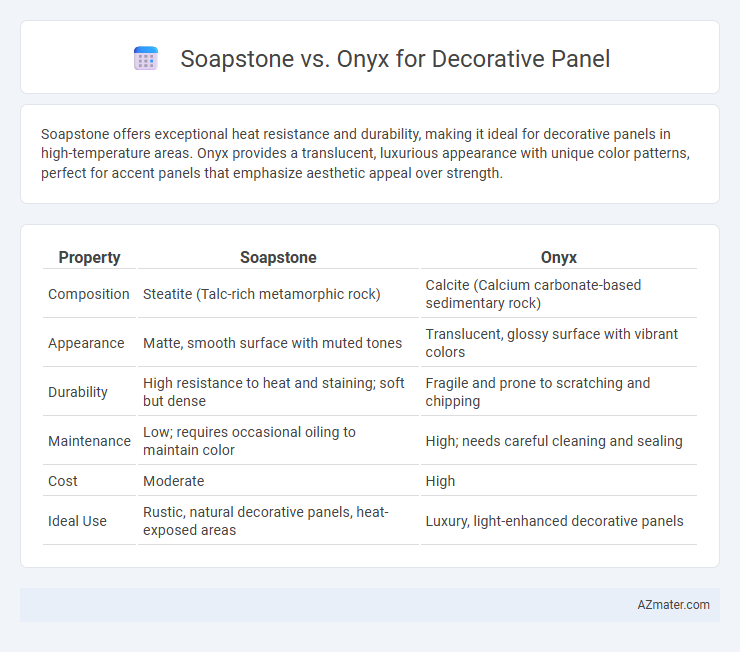Soapstone offers exceptional heat resistance and durability, making it ideal for decorative panels in high-temperature areas. Onyx provides a translucent, luxurious appearance with unique color patterns, perfect for accent panels that emphasize aesthetic appeal over strength.
Table of Comparison
| Property | Soapstone | Onyx |
|---|---|---|
| Composition | Steatite (Talc-rich metamorphic rock) | Calcite (Calcium carbonate-based sedimentary rock) |
| Appearance | Matte, smooth surface with muted tones | Translucent, glossy surface with vibrant colors |
| Durability | High resistance to heat and staining; soft but dense | Fragile and prone to scratching and chipping |
| Maintenance | Low; requires occasional oiling to maintain color | High; needs careful cleaning and sealing |
| Cost | Moderate | High |
| Ideal Use | Rustic, natural decorative panels, heat-exposed areas | Luxury, light-enhanced decorative panels |
Introduction to Soapstone and Onyx Decorative Panels
Soapstone decorative panels offer exceptional durability and resistance to heat and stains, making them ideal for long-lasting interior applications with a natural, matte finish. Onyx decorative panels provide a translucent, luxurious aesthetic with natural veining that enhances lighting effects, commonly used in high-end design for creating striking feature walls. Both materials serve distinct purposes in decorative panels, balancing functionality and elegance depending on the desired ambiance and environmental conditions.
Aesthetic Differences: Soapstone vs. Onyx
Soapstone offers a matte, muted surface with subtle veining in shades of gray and green, creating a natural, earthy aesthetic ideal for understated elegance. Onyx features a translucent, glossy finish with bold, dramatic patterns and vibrant colors like amber, honey, and white, making it perfect for striking, luxurious decorative panels. The choice between soapstone and onyx depends on whether a space benefits from a soft, organic look or a luminous, eye-catching centerpiece.
Color and Pattern Variations
Soapstone offers a range of soft, muted colors such as grays, greens, and blues with subtle veining patterns that provide a natural, understated elegance for decorative panels. Onyx features vivid, translucent hues including amber, white, and green, characterized by dramatic, flowing patterns and striking banding that create a bold visual impact. Choosing between soapstone and onyx depends on the desired aesthetic, with soapstone favoring earthy tones and smooth textures while onyx delivers vibrant color contrasts and intricate designs.
Durability and Longevity Comparison
Soapstone offers excellent durability with high resistance to heat, stains, and scratches, making it a practical choice for long-lasting decorative panels. Onyx, while visually stunning with its translucency and unique veining, is softer and more prone to scratching and chipping, which may reduce its longevity in high-traffic areas. For durability and extended lifespan, soapstone outperforms onyx by maintaining structural integrity under regular wear and environmental exposure.
Maintenance and Cleaning Requirements
Soapstone requires minimal maintenance due to its non-porous nature, resisting stains and scratches, and only needs occasional mineral oil application to maintain its rich appearance. Onyx, being more porous and delicate, demands careful cleaning with pH-neutral cleaners and regular sealing to prevent etching and discoloration from moisture and acidic substances. In decorative panel applications, soapstone offers greater durability and easier upkeep, while onyx needs more attentive care to preserve its natural translucency and vibrant patterns.
Suitability for Interior and Exterior Applications
Soapstone offers excellent durability and weather resistance, making it highly suitable for both interior and exterior decorative panels, especially in kitchens and outdoor patios. Onyx provides a luxurious, translucent appearance ideal for interior applications like wall cladding and backlit panels but lacks the hardness and UV resistance required for exterior use. Choosing between soapstone and onyx depends on the project's exposure to environmental elements and the desired aesthetic effect.
Cost and Value Analysis
Soapstone offers a cost-effective option for decorative panels, with prices typically ranging from $40 to $70 per square foot, making it a budget-friendly choice without compromising durability. Onyx, being a rare and luxurious material, commands a significantly higher price, often between $100 and $250 per square foot, reflecting its unique translucency and aesthetic appeal. Value analysis highlights soapstone's long-lasting nature and heat resistance suitable for practical applications, while onyx delivers unparalleled elegance and visual impact, justifying its premium cost in high-end design projects.
Installation Considerations
Soapstone panels are easier to install due to their softer texture and lighter weight, allowing for straightforward cutting and shaping with basic tools. Onyx decorative panels require careful handling during installation because of their brittleness and translucency, often necessitating professional expertise and specialized adhesive to prevent cracking. Both materials demand a stable, level substrate to ensure long-lasting adhesion and alignment.
Environmental Impact and Sustainability
Soapstone is a natural metamorphic rock known for its durability and low environmental footprint, as it requires minimal processing and emits fewer pollutants during extraction. Onyx, a form of calcite, often involves energy-intensive quarrying and significant material waste, leading to higher environmental impacts. Choosing soapstone for decorative panels enhances sustainability due to its longevity, recyclability, and lower embodied energy compared to the more fragile and resource-intensive onyx.
Which is Better: Soapstone or Onyx for Decorative Panels?
Soapstone offers superior durability and heat resistance, making it an excellent choice for decorative panels in high-traffic or warm environments, while onyx excels with its translucent beauty and luxurious appearance, creating stunning visual impact in lower-traffic areas. Soapstone's dense, non-porous nature ensures easier maintenance and longevity, whereas onyx requires careful sealing and gentle upkeep to preserve its delicate surface. Choosing between soapstone and onyx depends on balancing practical durability against aesthetic elegance for your specific decorative panel needs.

Infographic: Soapstone vs Onyx for Decorative Panel
 azmater.com
azmater.com